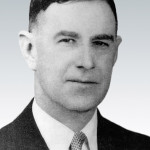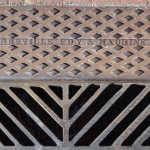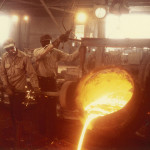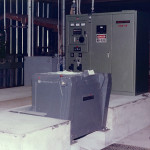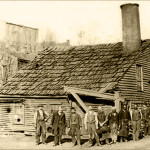 First Foundry in Montgomery County, Tennessee located on Commerce Street near downtown Clarksville at the site of the original town spring and operates under the name of Clarksville Foundry & Machine Shop.
First Foundry in Montgomery County, Tennessee located on Commerce Street near downtown Clarksville at the site of the original town spring and operates under the name of Clarksville Foundry & Machine Shop.
About Us
Timeline
1847 – 1899 
 American Civil War is underway and Whitfield, Bradley & Co is used as a munitions factory for the Confederacy during the War Between the States. In 1862, the Foundry operations cease upon the capture of Clarksville by the Union Army. Metallography is developed by Henry C. Sorby of Sheffield, England, in 1863, enabling foundrymen to polish, etch and microscopically examine metal surfaces for physical analysis.
American Civil War is underway and Whitfield, Bradley & Co is used as a munitions factory for the Confederacy during the War Between the States. In 1862, the Foundry operations cease upon the capture of Clarksville by the Union Army. Metallography is developed by Henry C. Sorby of Sheffield, England, in 1863, enabling foundrymen to polish, etch and microscopically examine metal surfaces for physical analysis.
An era of Modernization … in 1893 steam and gasoline engines are introduced.

Name Changes to Whitfield & Co. in 1857 when J.P.Y. Whitfield, Thomas Pritchett and R.M. House buy H.P. Dorris’ interest. The Clarksville Foundry name changes again in 1858 to Whitfield, Bradley & Co. when Larkin Bradley and James Clark buy the interests of Pritchett and House.
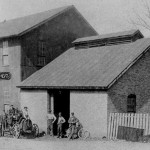 Foundry Operations Resume and Name Changes to J.A. Bates & Co. In 1869 the name change to Whitfield, Bates & Co. In 1892 Wesley Drane purchases an interest and the firm operates as Whitfield, Drane & Co. until S.M. Drane, Jr. and C.H. Drane purchase Whitfield’s interest and the firm becomes known as Drane & Co.
Foundry Operations Resume and Name Changes to J.A. Bates & Co. In 1869 the name change to Whitfield, Bates & Co. In 1892 Wesley Drane purchases an interest and the firm operates as Whitfield, Drane & Co. until S.M. Drane, Jr. and C.H. Drane purchase Whitfield’s interest and the firm becomes known as Drane & Co.
1900 – 1949 
 New equipment brings industry changes when, in 1900, the Brinell hardness test machines were introduced. In 1902, the foundry begins manufacturing the Ground Hog Plow when Drane & Co. purchases patent rights on the Ground Hog Plow from James Rossiter resulting in the incorporation of Ground Hog Plow & Foundry Company.
New equipment brings industry changes when, in 1900, the Brinell hardness test machines were introduced. In 1902, the foundry begins manufacturing the Ground Hog Plow when Drane & Co. purchases patent rights on the Ground Hog Plow from James Rossiter resulting in the incorporation of Ground Hog Plow & Foundry Company.
Thomas (T.B.) Foust leases the foundry and machine shop from Red River Furnace Company and operates as Clarksville Foundry & Machine Works on the Red River Street site. In 1915, experimentation begins with bentonite, a colloidal clay exhibiting high green strength and dry strength. The same year, the first low-frequency induction furnace for nonferrous melting is installed in Philadelphia. On May 9, 1917, Clarksville Foundry & Machine Works is incorporated.
Ductile iron is invented in 1943 and opens the door to many new applications. It provides flexibility and strength previously unavailable with iron casting. The Commerce Street foundry ceases operation in 1946, but that location continues as the site of machine, welding and blacksmith shops. In 1949, a U.S. patent on ductile iron production through magnesium treatment is issued.

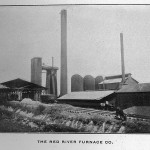 The Red River Furnace Company, parent company of Clarksville Foundry & Machine Company, is featured in the 1903 Tennessee Central Magazine. In 1906, Clarksville Foundry & Machine Company is incorporated by Graham MacFarlane, et al. Located on the site of the modern day Clarksville Foundry, Inc., Red River Furnace operates a blast furnace nearby for the production of pig iron. Read 1903 Tennessee Central article
The Red River Furnace Company, parent company of Clarksville Foundry & Machine Company, is featured in the 1903 Tennessee Central Magazine. In 1906, Clarksville Foundry & Machine Company is incorporated by Graham MacFarlane, et al. Located on the site of the modern day Clarksville Foundry, Inc., Red River Furnace operates a blast furnace nearby for the production of pig iron. Read 1903 Tennessee Central article
Name changes from Ground Hog Plow & Foundry when the plow patents are sold to W.J. Oliver of Knoxville, TN. The new name, Drane Foundry & Supply Company, denotes their entrance into the supply business. The same year, matchplates are developed, which made jolt-squeeze sand molding machines successful. In 1911, the first electric arc furnace for metal casting is installed at Treadwell Engineering, Co., Easton, Pennsylvania.
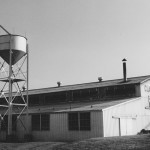 First Foust family era of foundry when T.B. Foust buys Drane Foundry & Supply Company’s stock of material and supplies and leases their land and buildings. In 1922, T.B. Foust purchases Drane’s land and buildings on Commerce Street at auction. This is the site and operation established by H.P. Dorris in 1847. The following year, Clarksville Foundry & Machine Works, Inc. buys the property and equipment at the Red River Street site giving the company two locations engaged in metal casting operations. By 1930, the first high-frequency coreless electric induction furnace is installed in Pennsylvania and spectrography is pioneered by University of Michigan professors for metal analysis.
First Foust family era of foundry when T.B. Foust buys Drane Foundry & Supply Company’s stock of material and supplies and leases their land and buildings. In 1922, T.B. Foust purchases Drane’s land and buildings on Commerce Street at auction. This is the site and operation established by H.P. Dorris in 1847. The following year, Clarksville Foundry & Machine Works, Inc. buys the property and equipment at the Red River Street site giving the company two locations engaged in metal casting operations. By 1930, the first high-frequency coreless electric induction furnace is installed in Pennsylvania and spectrography is pioneered by University of Michigan professors for metal analysis.
World War II causes foundry business to soar. The foundries at both locations operate in response to the war effort and for a time, over 100 men are employed.
1950 – 1999 
 The Foundry ceased operations in January 1974 for five months due to decreasing markets and numerous changes in the industry. The Foundry was experiencing a decline in demand for municipal castings, the poor economy, an increase in foreign competition, the advent of plastic and concrete products and the implementation of sweeping new air pollution regulations by the federal government. Instead of permanently closing its doors as many competitors were forced to do, Clarksville Foundry makes bold moves to bring the operation within new EPA guidelines. In June of the same year, Clarksville Foundry reopens with permission to use its old cupola furnace until a new one that meets pollution regulations can be installed. On March 26, 1975, a new oil-fired rotary furnace becomes operational.
The Foundry ceased operations in January 1974 for five months due to decreasing markets and numerous changes in the industry. The Foundry was experiencing a decline in demand for municipal castings, the poor economy, an increase in foreign competition, the advent of plastic and concrete products and the implementation of sweeping new air pollution regulations by the federal government. Instead of permanently closing its doors as many competitors were forced to do, Clarksville Foundry makes bold moves to bring the operation within new EPA guidelines. In June of the same year, Clarksville Foundry reopens with permission to use its old cupola furnace until a new one that meets pollution regulations can be installed. On March 26, 1975, a new oil-fired rotary furnace becomes operational.
 Clarksville Foundry consolidates Operations to a single site in order to continue improving operational inefficiencies. Construction of a new main office and technology upgrades take place. The historic Commerce Street properties are sold to the City of Clarksville and become the site of new city office buildings.
Clarksville Foundry consolidates Operations to a single site in order to continue improving operational inefficiencies. Construction of a new main office and technology upgrades take place. The historic Commerce Street properties are sold to the City of Clarksville and become the site of new city office buildings.

Clarksville Foundry takes over production of the world famous line of corn shellers, grist mills and related products when the A.H. Patch factory shuts down. The original patterns are still in storage. T.B. Foust passes away after serving as company president from 1930 until May 27, 1966, when he is succeeded as president by George (G.T.) Foust, with Charles and Tom, Jr. remaining as vice presidents.
 Charles E. Foust Sr. succeeds retiring George Foust as President. The following year, Charles Foust Jr. graduates at the top of his class. Upon graduating in mechanical engineering from the University of Tennessee in 1978, he returns to Clarksville to work in the family business. He initiates programs to modernize processes, upgrade aging equipment and seek new markets. Tom Foust Jr. retires in January 1980, and Charles Foust Jr. becomes Vice-President. The following year, 1981, Charles Foust Jr. becomes company president and begins to initiate technology upgrades and shifts in product emphasis. His father remains active in all phases of the business.
Charles E. Foust Sr. succeeds retiring George Foust as President. The following year, Charles Foust Jr. graduates at the top of his class. Upon graduating in mechanical engineering from the University of Tennessee in 1978, he returns to Clarksville to work in the family business. He initiates programs to modernize processes, upgrade aging equipment and seek new markets. Tom Foust Jr. retires in January 1980, and Charles Foust Jr. becomes Vice-President. The following year, 1981, Charles Foust Jr. becomes company president and begins to initiate technology upgrades and shifts in product emphasis. His father remains active in all phases of the business.
Clarksville Foundry is listed on the National Register of Historic Places.
 The Tennessee Small Business Person of the Year is Charles Foust Jr., who is recognized for his business savvy during adverse situations that resulted in astounding turnaround growth and prosperity for Clarksville Foundry. Read 1994 Nashville Business Journal Article
The Tennessee Small Business Person of the Year is Charles Foust Jr., who is recognized for his business savvy during adverse situations that resulted in astounding turnaround growth and prosperity for Clarksville Foundry. Read 1994 Nashville Business Journal Article
2000 – Present 
 Rosette Bobbin Wins the 2005-06 Samuel B. Barker Outdoor Sculpture Competition held at the University of Alabama at Birmingham, due to casting by Clarksville Foundry and participation with three other U.S.-based foundries. The sculpture resides outside the 1901 Spencer Honors House (at UAB), formerly the Second Presbyterian Church, where Martin Luther King Jr. once spoke during the civil rights era. A full-size replica resides outside Clarksville Foundry. Read more.
Rosette Bobbin Wins the 2005-06 Samuel B. Barker Outdoor Sculpture Competition held at the University of Alabama at Birmingham, due to casting by Clarksville Foundry and participation with three other U.S.-based foundries. The sculpture resides outside the 1901 Spencer Honors House (at UAB), formerly the Second Presbyterian Church, where Martin Luther King Jr. once spoke during the civil rights era. A full-size replica resides outside Clarksville Foundry. Read more.
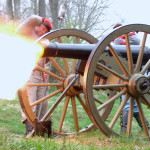 Clarksville Foundry’s reproduction cannon is permanently installed at Fort Defiance Civil War Park and Interpretive Center as a gift to the community. Civil War re-enactors from Porter’s Battery fire the cannon during grand opening events in April 2011. Read More.
Clarksville Foundry’s reproduction cannon is permanently installed at Fort Defiance Civil War Park and Interpretive Center as a gift to the community. Civil War re-enactors from Porter’s Battery fire the cannon during grand opening events in April 2011. Read More.
 Clarksville Foundry Becomes Green Certified as a business in Clarksville-Montgomery County when older equipment is replaced with energy efficient models for the casting process and practices are instituted to recycle and reduce waste in its administrative functions. Read More.
Clarksville Foundry Becomes Green Certified as a business in Clarksville-Montgomery County when older equipment is replaced with energy efficient models for the casting process and practices are instituted to recycle and reduce waste in its administrative functions. Read More.
 Clarksville Foundry produces aluminum castings to replicate three rosette windows at First Presbyterian Church. The Gothic Revival structure from 1878 is one of five churches listed on the National Register of Historic Places. Earlier that year, William “Bill” Foust joins Clarksville Foundry. Bill Foust, Charles’ son and the fourth generation of the family to work at Clarksville Foundry, serves as a General Manager / Vice President. Read More.
Clarksville Foundry produces aluminum castings to replicate three rosette windows at First Presbyterian Church. The Gothic Revival structure from 1878 is one of five churches listed on the National Register of Historic Places. Earlier that year, William “Bill” Foust joins Clarksville Foundry. Bill Foust, Charles’ son and the fourth generation of the family to work at Clarksville Foundry, serves as a General Manager / Vice President. Read More.

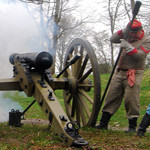 Reproduction of 1841 “Six Pounder” cannon is crafted using historic drawings. The completed cannon, temporarily located at the Montgomery County Courthouse, is fired to kick off the Civil War Sesquicentennial. The video “From Molten Metal to Cool Castings,” documenting the cannon project to illustrate the casting process, is also completed.
Reproduction of 1841 “Six Pounder” cannon is crafted using historic drawings. The completed cannon, temporarily located at the Montgomery County Courthouse, is fired to kick off the Civil War Sesquicentennial. The video “From Molten Metal to Cool Castings,” documenting the cannon project to illustrate the casting process, is also completed.
 Foundry Celebrates 100 Years as a Family-Owned Business the same year that Charlie Foust Jr. will step in as chairman of the Clarksville Area Chamber of Commerce. Read More.
Foundry Celebrates 100 Years as a Family-Owned Business the same year that Charlie Foust Jr. will step in as chairman of the Clarksville Area Chamber of Commerce. Read More.
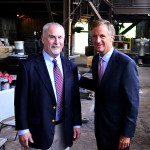 Clarksville Foundry is Chosen by Tennessee Gov. Bill Haslam as the site for the ceremonial signing of the landmark Workers’ Comp Reform Act of 2013. The foundry was chosen because of their longstanding history of success and dedication to business growth in Tennessee. Read More.
Clarksville Foundry is Chosen by Tennessee Gov. Bill Haslam as the site for the ceremonial signing of the landmark Workers’ Comp Reform Act of 2013. The foundry was chosen because of their longstanding history of success and dedication to business growth in Tennessee. Read More.
1140 Red River Street Clarksville, TN 37040 931-647-1538 ![]()
© 2022 Clarksville Foundry. All rights reserved. Images may not be published, rewritten or redistributed, in whole or part, without the written permission of Clarksville Foundry or without proper credit given to Clarksville Foundry.
All orders accepted by Clarksville Foundry, Inc. are subject to our Terms and Conditions of Sale.


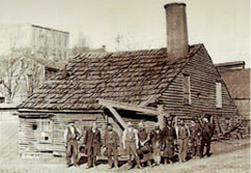 Clarksville’s first foundry, 1847.
Clarksville’s first foundry, 1847.
